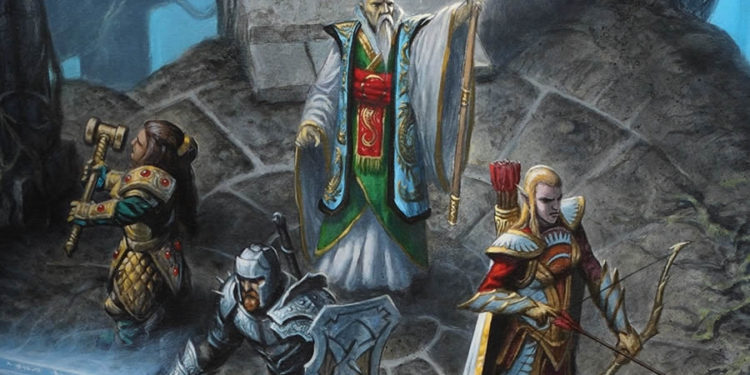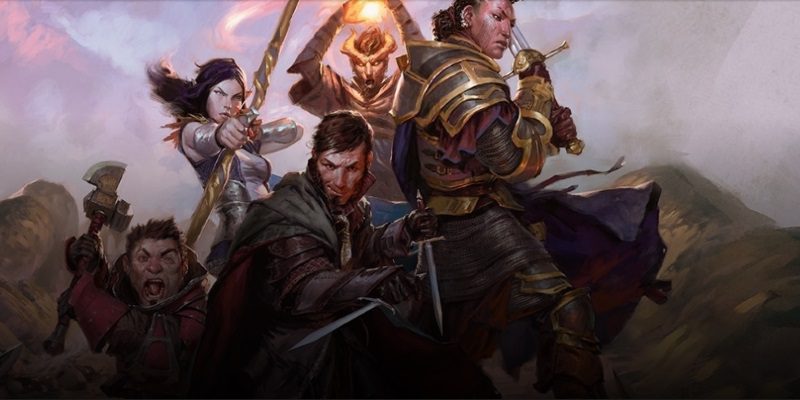Unearthed Arcana: Traps Breakdown

This week’s Unearthed Arcana comes to us from the office of Mearls, Crawford, and the Mon Calamari Admiralty. These rules expand on the trap rules found in the DMG, with considerably more guidance for creating new traps and providing new rules for Complex Traps. Complex traps are mentioned in the DMG, but there isn’t a lot of detail there. We’re also going to ram head-first into the fundamental problem of traps in D&D’s class dynamic, and I’ll discuss that a bit as we go.
Simple Traps
Right off the bat, there’s a shift in trap presentation: noting the level range in which the trap is a viable threat (moderate/dangerous/deadly), rather than making you back-form its level based on its damage output. It’s a little thing, but this makes DMs’ lives easier all by itself.
There’s half a page on how the DM should present simple traps, comparable to but different from the half a page on the same subject in the DMG. The DMG text suggests that characters can attempt non-skill-check-based countermeasures, such as triggering the trap from a non-threatened position. Conversely, the UA text says that should narrate their interactions with a trap in detail: “A player can’t just say, ‘I use thieves’ tools to disable it.’” The trouble is that the trap entries do exactly nothing to help the player or DM attach some meat to those bones, since the Countermeasures section of the traps in this document is egregiously unhelpful. For example, the Fiery Blast trap’s Countermeasures offers two skill uses and a spell use, but when there’s a skill check to learn what to do and no check for how to do it (such as “A DC 15 Intelligence (Religion) check allows a creature to destroy the trap by defacing a key rune in the mosaic”), I’m not sure how the player or the DM go about making that defacement interesting. I feel like the resultant dialogue is:
PC: Do I know anything about how to fix this?
DM: Hmm, maybe, roll Intelligence (Religion).
PC: Cool, I rolled a 17.
DM: Great! You know that if you deface that rune right there, just so, you will shut down the whole trap.
PC: Sweet. I do that.
Because, really, how many compelling ways are there to deface a rune on a mosaic that the DM hasn’t lovingly hand-drawn? (Do not get hung up on your pet example. If your solution is okay once and tedious twice, it is not a good solution.) This is part of the core problem of trap play. I recall an excellent sidebar in 4e… probably the DMG?… that laid out a bunch of reasons that random one-shot traps in an otherwise plain hallway were damaging to the flow of gameplay and everyone having a good time. And for all that setup, it probably comes down to one die roll, unless the DM rules that the trap is simply solved. To those I would add, the more time the DM spends describing every detail of a trap mechanism, creating a challenge that only one PC can engage with, and expecting that player to respond with a convoluted and paranoid trap solution, the less time you’re spending getting to the fucking monkey – an encounter that involves more of the party.
For all that, though, the new trap presentation that calls out Trigger, Effect, and Countermeasures clearly is 110% better than 2+ paragraphs that bury the lede. There are a selection of nine traps, some of which are remixes of DMG traps, but most of which are new (if still staying within classic trap motifs). I don’t know about you, but somewhere over the years I lost the ability to think of a scything blade trap by that name – as far as I’m concerned, it’s called only the penitent man will pass. Anyway. There are a few places where attack bonuses, saving throw DCs, skill check DCs, and damage don’t perfectly align with the guidelines in the Designing Simple Traps section below, but it doesn’t really matter. There’s nothing broken about traps having one element (other than damage, never get damage “wrong”) a step high or a step low.
Thinking back to 3.x, I recall that trap play fell away pretty sharply after 10th level, as the designers felt they couldn’t reasonably keep scaling up damage, DCs, and so on – and spellcasters had so many utility solutions for traps that there didn’t seem much point. 5e clearly rejects that idea (as did 4e), and this document continues that. I think it’s interesting that top-tier deadly traps carry not just one 9th level spell – usually the last word in wrecking your day – but also a 5th-level spell to get the job done.
Because this document replaces and expands on a whole section found in the DMG, there’s more explanatory text than we’ve seen in other UAs, excepting maybe the one revamping encounter-building techniques. There’s not a lot to comment on in them, as they’re what you’d expect to see and their guidance is sane. One of my few quibbles is that I’d like to see a few more classes of simple traps that draw in more skills. As it is, Strength (Athletics), Dexterity (thieves’ tools), and Intelligence (Arcana) are big winners, and only a tiny number of traps call for anything else. I mention it every time it comes up, but I’m always happy to see proficiency in thieves’ tools in the hands of another class or subclass, just as I’m happy that classes other than cleric can carry the healing burden in 5e.
My one outstanding question for spell-traps is how the designers believe Concentration should work. In a session my wife ran yesterday, we got some firsthand experience with just how brutal heat metal is in 5e. (No initial attack roll or saving throw? Gwuh? It would be malice murder without its Concentration duration.) There are a number of good solutions here, so I’m just curious as to which one is official.
Complex Traps
I don’t think it any great stretch to call this sneaking skill challenges into 5e. Unlike simple traps, complex traps are intended to be the whole encounter in themselves. These are certainly as complicated as boss-fight design, and I’m not really sure they’ve got the data presentation in its best state yet – though that’s hardly a fair criticism for their first time out of the gate. Just looking at the examples, I appreciate how much of a debt they owe to the Indiana Jones films here.
Anyway, complex traps act either once or twice in a round, on one or both of initiative counts 20 and 10. On those initiative counts, they do something terrible to you. They also have a series of triggers that cause them to change in some way during the encounter – the example complex traps all have at least one Dynamic Element to increase damage output. These don’t quite scale up to soft-enrage-timer territory, but I imagine that even high-level characters (other than all those stupid poison-immune characters… folks, this is what I’ve been on about) would find 10d10 poison damage to be something they should solve sooner rather than later.
I think there’s one substantial problem in the design of the Path of Blades. It’s listed as being Dangerous for levels 1-4, but one of its solutions is three dispel magic spells on its Rune of Fear element. It’s also kicking out one-hit-kill damage, for such low-level characters as you make progress toward solving it. Every part of the trap gets stronger as you make progress on the Rune, but it’s not clear how the players would even understand that the growing power of the blades and the rune are a good sign and not the DM telling them that they should try something else. What I’m saying is, those results look like a failure state to me, and that means you’re teaching PCs to stop working on the problem (even as they’re getting hammered with whirling blades and falling pillars). The Dynamic Element – Blades Miss grants a stacking +2 to hit, which means that actions spent on Countermeasures really look like wasted time – and you never want any “correct” action to look like wasted time. That’s even more damaging in a high-tension situation. I would strongly encourage DMs to consider being more transparent with action options, likely outcomes, and results than they would otherwise be, because players won’t be able to engage with what’s going on otherwise.
Basically, this feels very much like it would fit into an MMO, where players can wipe and try again. On the other hand, I like that the Gloves Are Off and PCs might need to retreat, recover a body, and reconsider. I’m just not sure its danger level is accurate. Admittedly, it might be too easy, especially for very high movement speed characters. Tabaxi rogues, maybe. I think these are the kinds of problems you expect to see in playtest material, though.
Digging into the quite extensive advice of the Designing Complex Traps section, I note that the Rune of Fear ignores this guidance explicitly. This section also recognizes that making three skills carrying 90% of the load means that there are going to be some very bored (but still taking damage) party members, and it’s up to player engagement and DM improvisation to keep everyone entertained. In itself, that suggests to me that this more open style might be a very bad fit for Adventurer’s League play. I am not involved in the AL, but I’ve gotten the impression that it leaves very little room for DMs to offer alternate adjudication.
Overall, I feel that this playtest document is a return to form for UA – not perfect (its internal contradictions are a little strange, but minor), but solid and immediately playable, with clear thematic ideas at stake – following last week’s more regrettable release. I think the advice may be a bit overwhelming for novice DMs, unless they’re experienced video gamers and accustomed to pressing A to not die; however, it’s great for helping more seasoned DMs who haven’t already mastered this particular kind of design. I’d love to see this lead to a tailored-for-5e revival of Grimtooth’s Traps, maybe spun less silly and more high-adventure. Complex traps are not the kind of encounter you want to have to create on the fly.
What I really want, though, is a sweet-spot blend of complex traps and boss monsters. Oh, and ideas on how to frame “trap” elements as the natural effects of crumbling ruins, technology gone wrong, that kind of thing. I’m guessing you’ve played a video game before and get what I’m talking about.



